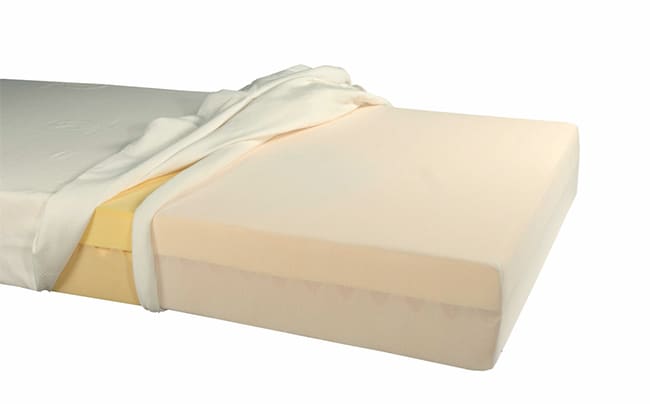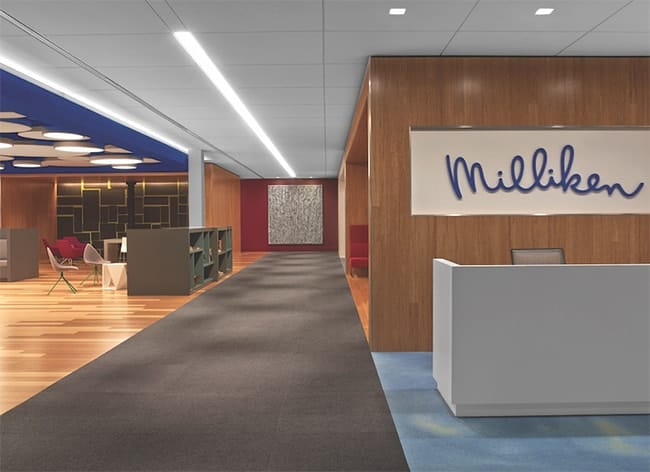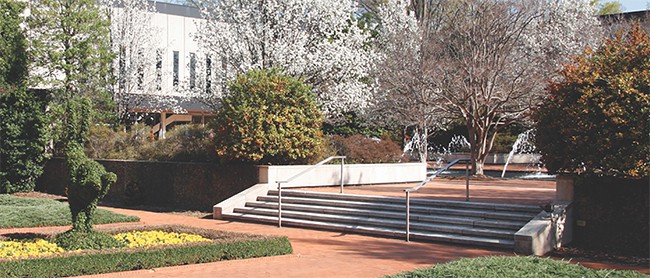BY GARY JAMES
Through Innovarest brand, supplier goes beyond FR nonwovens with specialty textiles and more

New branding Spartanburg, South Carolina-based Milliken & Co. has launched a new branding initiative for its bedding components called Milliken Innovarest. Tim Meade is market director for Innovarest, which he says, ‘clearly articulates Milliken’s ability to innovate and provide products designed to help you rest well.’
Reflecting the evolution of its sleep textiles line beyond FR nonwovens into knits, laminates and other bedding components, Milliken & Co. has launched a major branding initiative called Milliken Innovarest. The new brand positions the company for continued expansion into other product categories and innovative solutions for the industry.
“As our product offering has evolved from being only an FR nonwoven supplier to a much broader line of materials in the mattress, we realized the need for a name that better reflects what we do,” says Tim Meade, market director of Milliken Innovarest, based in Spartanburg, South Carolina. “We believe Innovarest clearly articulates Milliken’s ability to innovate and provide products designed to help you rest well.”
Innovarest includes a full line of FR nonwovens, knits and laminated materials. The company’s high-loft and knit barrier solutions feature inherent FR properties engineered directly into the material. Innovarest mattress textiles include fiber board support, insulator pads and Loftec comfort layers.
In addition, the branding initiative includes a new website, Innovarest.Milliken.com, which features interactive diagrams of innerspring, foam and hybrid mattresses that showcase Innovarest products. It also touts Milliken’s in-house, A2LA-accredited burn lab for mattress flammability testing.
“We have a 152-year heritage of innovation and that history includes many years of involvement with the bedding industry,” Meade says. “With our new brand, we’re deepening our commitment to bedding and positioning ourselves as a trusted partner for a variety of sleep product solutions beyond just nonwovens.”
Long history of innovation
Founded in 1865 by William Deering and Seth Milliken as a small woolen fabric jobbing enterprise, it originally was known as Deering Milliken Co. When Deering left several years later to start a farm machinery company, Milliken moved the headquarters from Portland, Maine, to New York City—then the heart of the U.S. textile industry.
In its early days, Deering Milliken primarily was a textile wholesaler focused on optimizing the flow of goods between manufacturers and retailers. Over time, it began investing in textile mills to improve control over its supply chain, something unheard of at the time. One of the company’s first purchases was the acquisition of a manufacturing facility in Pacolet, South Carolina, in 1884.
In the early 20th century, Deering Milliken transformed from a wholesaler into a manufacturer. The company was one of the first to realize the potential of man-made fibers. The pace of innovation picked up after World War II with the establishment of a research group in South Carolina. Out of it came forerunners of important technologies to come, including two-for-one twisting, single-end sizing and acrylic yarn dyeing. Deering Milliken launched a chemical manufacturing division in 1957. The result was a number of high-performance fabric advancements, including Agilon nylon yarn, used in women’s hosiery; Belfast, the first self-ironing 100% cotton fabric; and Visa polyester, a fabric that can release stains and soils in one wash.
Roger Milliken, grandson of founder Seth Milliken, became president of Deering Milliken in 1947 after the death of his father, Gerrish Milliken. The company moved its headquarters to its current site in Spartanburg in the late 1950s. And, in the 1970s, with the creation of its proprietary digital carpet printing—Millitron—Milliken entered the area rug business and changed the face of floor coverings. In 1976, Deering Milliken officially became Milliken & Co.
Today, Milliken & Co. is a privately held diversified manufacturing company with more than 7,000 employees worldwide and more than 35 manufacturing facilities in Australia, Belgium, China, France, India, the United Kingdom and the United States. Long known for its “knowledge-based investment,” Milliken employs more than 100 Ph.D.s and has accumulated more than 2,200 U.S. patents—and more than 5,000 patents worldwide. Its expertise stretches across 20 distinct markets and across a range of disciplines, including specialty chemical, floor covering, and performance and protective textiles.
Milliken’s purpose is “to do good for the world, to create new experiences and to build for the future,” says Meg Ried, sales enablement manager for Milliken Innovarest. The company’s approach to product innovation is driven by “inspired and passionate engagement” in three key areas: “unique insights”—a proprietary discovery that identifies, frames and defines the design problem to be solved; “deep science”—a mastery of the underlying chemistry and physics of nature that enables meaningful design; and “meaningful design”—the functional, elegant architecture of a product or service that changes the way users think and feel about the experience.
“Our innovations are everywhere,” Meade says. “The average American may interact with a Milliken innovation up to 50 times a day but just doesn’t know it because often our products are not directly sold to end users/consumers. Our contributions are usually ‘hiding in plain sight.’ ”

Into FR since the 2007 spark Milliken began offering FR products to the bedding market when the federal open-flame standard went into effect in the United States in 2007. Its Innovarest FR knit line includes a range of products suitable for use with memory, gel and latex foams.
A pioneer in FR
In the bedding arena, Milliken’s presence deepened in 2007 when the federal open-flame standard, 16 CFR Part 1633, went into effect in the United States. The company already had developed specialty fiber with FR properties for automotive heat shields and that research provided the basis for a new line of FR bedding barriers called Paladin.
“We started with FR nonwovens, then added polyester products, fiber pads and fiber fill,” Meade says. “From there, we added the ability to laminate our product to ticking, as well as FR knit socks for foam core beds. More recently, we’ve moved into engineered comfort layers designed to match the performance of a variety of different foams.”
While Milliken continues to market its FR solutions as Paladin (at least for the near future), the new Innovarest brand provides a broader umbrella for all the company’s bedding-related textiles, including products in development.
“Temperature control and moisture management are two big areas we are working on right now,” Meade says. “We’re looking to develop new, better solutions not already available that improve the users’ sleep experience.”
Because Milliken’s R&D activity touches so many different markets, the company has a deep pool of expertise to draw on as it develops products and technologies. FR is a core competency in the company and is used to develop workwear for the military, firefighters, and the oil and gas industry. Because these types of workers spend so much time in hot environments, Milliken has been focusing efforts on temperature control, particularly cooling. The research holds promise for sleep products—bed producers always are on the lookout for new ways to manage temperatures and moisture levels.
Feelin’ the burn
With all its research, Milliken works closely with key customers to identify areas of interest and need. This approach has been a cornerstone of its success in the FR arena, where customers often come to the company’s in-house Milliken PyroAnalytical Center to spend a day or more observing burn tests of products under development.
“At our burn lab, our team works closely with customers to help them quickly design the most cost-effective FR solution for their mattresses,” Meade says. “They may come into our facility without a clear idea of what they need, but by the end of the day, we’ve burned six different beds and given them a much better understanding of what works best for them, based on their specific cost and performance criteria.”
The Milliken PyroAnalytical Center is ISO 17025 certified and can perform both 16 CFR Part 1632 and 1633 mattress flammability tests.
In addition to FR testing, Milliken now conducts temperature- and moisture-management testing. “If we see something as an area where we need to develop a core competency then we invest in having the testing ability in-house,” Meade says. “Having this capability improves the quality of our research and it also allows us to come to market with proven data to back up product claims.”
All of Milliken’s testing facilities are independently accredited by third parties, Meade says, adding that the company also makes its labs available to customers for their use. “If a customer has a problem, even if it doesn’t involve one of our products, they’ll call us and we’re happy to help,” he says.

Modern digs Milliken was founded in 1865, but today it’s a thoroughly 21st-century enterprise, from its cutting-edge research-and-development efforts to the sleek interior of its headquarters. Photo courtesy of Eric Laignel
Evolving with the market
On the textile side, Milliken’s customer base includes the biggest mattress producers and many in the second tier, as well. Those relationships give Milliken a natural platform for expanding its base with products.
“Four years ago, we didn’t have any knit products suitable for latex,” Meade says. “Today, FR knits for latex foam are a growing part of our business. We started with two families of knit socks that worked on a limited number of foams and then expanded that to the point where we now have a range of product families.”
As it becomes more of a one-stop shop for its customers, Milliken sees its strong operational heritage as a competitive advantage. The company has multiple nonwoven plants on both U.S. coasts with warehousing capability, providing rapid service on knit socks and other best-sellers.
“Service has always been one of our strengths, along with our product offering and our FR expertise and technology,” Meade says. “We see our customers as partners, and we work closely together to help them find the right solution for their needs—and any new opportunities that may be emerging.”
Since the days of its founding, Milliken has worked hard to foster a culture of innovation. A good example of this spirit is the company’s annual Innovation Fair, during which its entire team of researchers and marketers gathers to share the latest information about new technologies and discoveries.
“A researcher may identify an interesting breakthrough without a defined application or market in mind,” Meade says. “At the fair, they can share this development with experts across all our company’s various disciplines and gain new insights on how the technology might be applied to a product or process.”
With the design, marketing and distribution of sleep products undergoing rapid change, this is an exciting time to be in the bedding industry, Meade says. “It’s seems like every day we’re learning about a new e-commerce player entering the business,” he says. “That’s having a major impact throughout the industry.”
While such change can be unsettling to established players, the attention being generated by the new wave of boxed-bed specialists also is creating an opportunity.
“More and more bed manufacturers and retailers are talking about how to help consumers get a good night’s sleep,” Meade says. “They’re looking for new ways to deliver better sleep and asking their suppliers and other partners for creative ideas about how to achieve that. With our research-and-development resources, Milliken is in a great position to support this effort.”
Chem lab: Milliken solutions improve PU foams
Textiles aren’t the only product category where Milliken & Co. plays a major role in the bedding industry. The Spartanburg, South Carolina-based company also supplies several chemical solutions—from colorants and antioxidants to anti-microbial chemistry—to polyurethane foam producers.
For more than 25 years, PU foamers throughout the world have been using Milliken’s Reactint colorant technology. Unlike pigment pastes, which are dispersions of solid particles in a liquid carrier, Reactint colorants are 100% homogenous liquids that are soluble in polyol and will not settle over time, the company says. By blending and mixing just five Reactint color bases, PU foamers can achieve virtually any hue.
“There’s a trend in bedding right now where foam cores are getting darker and darker,” says Jesse Shoultz, global marketing manager for performance colorants and ingredients at Milliken. “Since our technology uses reactive chemistry, it allows producers to create deep, dark colors without affecting the physical properties of the foam.”

Colorways Valencia, Spain-based Torres Espic SL uses Milliken’s Reactint colorants for its Ikon-brand viscoelastic foams and Resilén brand high-resilience foams to visualize top quality in addition to help demonstrate the support and comfort features of its mattress cores.
Photo courtesy of Torres Espic SL (TorresEspic.es)
Differentiating foam cores and toppers through color provides a cue to consumers that there are different layers in the bed, each with its own properties. “Our system enables foam manufacturers to easily create whatever shade they want ‘on the fly’ by mixing five basic colors,” Shoultz says.
Another Milliken product widely used in foam manufacturing is Milliguard AOX, a polyurethane stabilizer that protects foam from oxidation and other degradation during processing. The product also reduces scorch during foam production, as well as the discoloration, degradation and odor issues that can occur after foam is made, Shoultz added.
In 2016, Milliguard AOX-1 received the Innovation Award from EUROPUR, the European association of flexible PU foam block makers, and, in 2015, the product was honored with R&D magazine’s R&D 100 Award.
In addition to Reactint and Milliguard AOX, Milliken offers Alphasan and Alphasan AF—two solutions that protect polyurethane foam from microbial degradation. Alphasan uses the power of silver to protect against bacteria and microbes, while Alphasan AF uses zinc pyrithione.
Going forward, Milliken’s chemical group will continue to look for solutions that help mattress and foam manufacturers improve their products and the sleep experience, Shoultz says.
“Any time the textile group has a customer in (to headquarters), we take that opportunity to have a discussion about any chemical innovation needs they may have for their products,” he says. “We use that input to direct our researchers so that they focus their efforts on key issues of concern to the industry.”
Milliken was green before green was a thing
Long before sustainability was a buzzword, Milliken & Co. had programs in place to reduce waste and energy use at its operations.
Its pioneering work started as early as 1900, when it published its first recycling policy and started reusing packaging and textile materials. In 1912, the company made its first investment in renewable energy and, in 1960, then-President Roger Milliken formally mandated the responsible use of natural resources. Two years later, the Spartanburg, South Carolina-based company opened its own wastewater treatment plants.
In 1990, Milliken published a formal Global Environmental Policy and, in 1992, adopted its Zero Waste to Landfill Policy. In 2005, the company began harvesting landfill methane for energy.
“Sustainability has been a part of our DNA for many, many years,” says Meg Ried, sales enablement manager for Milliken Innovarest. “We consider our potential impact on the environment in everything we do.”

Responsible stewards Milliken & Co. diverts waste from landfills, uses renewable energy and maintains a 600-acre corporate arboretum at its headquarters in Spartanburg, South Carolina.
In support of this goal, all of Milliken’s knit products for bedding are certified to Oeko-Tex’s Standard 100, which verifies that Milliken’s knits are made from safe materials and in environmentally friendly facilities.
Operating in an environmentally sustainable manner is one key element of Milliken’s core values. Others are honesty, integrity and ethical behavior, defined in one simple idea: Do what is right.
“How Milliken grows is equally as important as how much we grow—this is an integral belief that each Milliken associate holds and that directs their work daily,” said J. Harold Chandler, Milliken chairman, president and chief executive officer, while accepting the 2017 World’s Most Ethical Company award from the Ethisphere Institute.
Milliken has been recognized as a World’s Most Ethnical Company for 11 years, every year since the award was first given in 2007, making it one of only 13 companies to receive that consecutive distinction. This year, it was one of only 20 privately held companies to receive the award.




